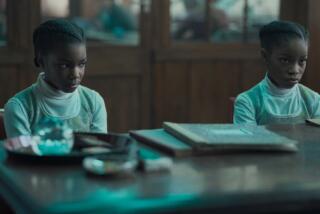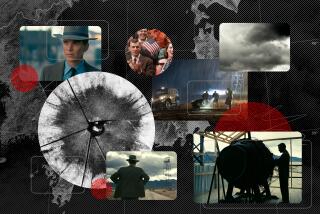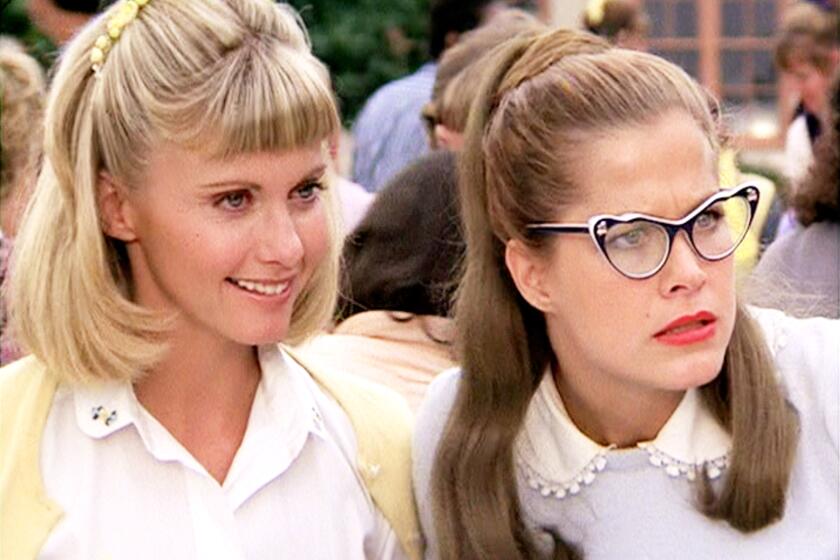KUBRICK’S CINEMATIC EYE IS BRILLIANTLY NEGATIVE
Many people have wondered why Stanley Kubrick, the American movies’ self-exiled perfectionist, turned to the Vietnam War for “Full Metal Jacket.” Hadn’t “Apocalypse Now,” “The Deer Hunter,” “Go Tell the Spartans” and, most tellingly, last year’s “Platoon,” scorched the cinematic earth on this subject?
But, perhaps the agony of Vietnam was an inevitable subject for him. In the last three decades, no matter what his apparent background or theme, Kubrick has become a master cinematic orchestrator of dread. Over and over again, in his films, in a style of shocking precision and strange beauty, he confronts us with horror and pain: the evils of warfare, murder, rape, oppression and, at the farthest pitch, nuclear annihilation.
Kubrick’s films have always seemed consumed by social injustice, and the inevitability of entropy, decay or death. The one notably upbeat resolution in his mature work--the enigmatic rebirth in “2001”--takes place after death, in a different life than ours.
For his victims, he usually sees no way out: the fate of the Marine recruits in “Full Metal Jacket.” In this film’s Parris Island opener, we see a ritual for molding impressionable young men into killers--one that succeeds too well. Then, in a “Vietnam” designed by a specialist in fantasy and fairy tales (Anton Furst of “The Company of Wolves”) some of those recruits are plunged into the Inferno: a landscape so rotten with peril, that even the most detached of them--Matthew Modine’s wise-cracking journalist, Joker--is seduced into destruction.
It’s a far different story than “Platoon.” Oliver Stone’s churningly hot, thrilling movie showed a battle between Good and Evil within the American Vietnam forces: resolved when Evil (Sgt. Barnes) assassinated Good (Sgt. Elias) and was, in turn, killed by the film’s witness (Pfc. Taylor.) But that dichotomy is mostly absent from the cooler, more cerebral “Full Metal Jacket.” Here, evil is pervasive, all-embracing. The first apparent villain, Gunnery Sergeant Hartman, is also the first victim. Other seeming victims--the mercilessly abused recruit Pyle, and the Viet Cong guerrilla--perform acts of extraordinary brutality.
In the end, the idea of finding heroes or villains in this morass of death becomes an awful joke. Kubrick leads us, calmly, into a contemporary nightmare: a world where slaughter and survival are the only hard constants, the only reality, the parameters of the trap.
Trapped: Kubrick--like Alfred Hitchcock and Fritz Lang--is a movie maker of dangerous cul-de-sacs. In his work, he has shown thieves locked in a jigsaw race track robbery where none of them will survive and time keeps obsessively spiralling back (“The Killing”); three innocent soldiers facing certain death in a rigged court-martial (“Paths of Glory”); Roman slaves in a doomed rebellion (“Spartacus”); a literary professor locked in a sexual obsession which, we know from the beginning, will drive him to murder (“Lolita”); the entire world plunged toward nuclear doomsday (“Dr. Strangelove”); astronauts on a spaceship light years from Earth, bedevilled by an insane computer (“2001”); a vicious teen-age psychopath made pawn in a battle between a repressive government and a lunatic dissident (“A Clockwork Orange”); an amoral gambler whose unscrupulous rise to riches carries the seeds of his fall (“Barry Lyndon”); and an alcoholic writer, snowbound with his family in an isolated hotel, driven by madness and demons to murder them (“The Shining”).
A unique catalogue of terror, and Kubrick, an ex-photojournalist, catches it with a jeweler’s eye. Most typically, a Kubrick film is a series of near-monomaniacal, dead-ahead moves into darkness or despair.
He uses a remarkable variety of visual and narrative devices to ensnare spectators in the uneasy field of his films. There’s the ironic, dispassionate narration; the rigid, mechanical tracking shot that imprisons characters like rats in a maze, inexorably drawing them to doom; the circular story construction; the referential musical (classics in his earlier films, and, in “Full Metal Jacket,” ’60’s rock, climaxing in the Rolling Stones’ blistering “Paint It Black”). There’s the tightly structured, symmetrical plot that leaves no opening for escape; the visual and verbal rhymes which irrevocably tie symbols of creation to destruction, of sex to death, and vice versa. (Think of his titles: “Fear and Desire,” “Killer’s Kiss”, “Dr. Strangelove--or How I Learned to Stop Worrying and Love the Bomb”).
The trap works both ways. These are not simple portrayals of innocent individuals persecuted by malevolent systems. Kubrick also shows man perverting and infecting the machinery. It’s Gen. Ripper’s sexual block--his anxiety over the poisoning of his “precious bodily fluids”--that triggers apocalypse in “Dr. Strangelove”; Gen. Mireau’s vanity that corrupts the court-martial in “Paths of Glory”; the Minister’s ambitions that trap a notably non-innocent Alex in “Clockwork Orange”; and the psychoses of the HAL-9000 computer, its programmed “human” responses, that sabotage “2001’s” mission.
And, in “Full Metal Jacket”, the “father,” Gunnery Sgt. Hartman, locked in a rigid mask and repetitive system, somehow teases Pyle, one of his “sons,” into murdering him--leaving the platoon as orphans in hell. Why? Personal dynamics? Or an inexorable pattern controlling them all?
It’s a tricky question. Kubrick is fascinated with the idea of systems--political, social or mechanic--that somehow become impregnated with human foibles and fears. In “Strangelove” bombers and transports flirt with each other, and the nuclear destruction of the world is Ripper’s only, and posthumous, sexual climax. The docking of the spaceship in “2001” is an ironic seduction and waltz, and the other spaceship shots are loaded with phallic and womb metaphors--sex caught and perverted in the machines.
In “Full Metal Jacket,” the idea that war and aggression can come from displaced sexuality receives an extreme expression. As the Marine recruits are molded into killers, they fondle their rifles, give them female names, and are repeatedly regaled by Sgt. Hartman with outrageously bawdy badinage--often from real-life drill camp jokes and jargon.
The Vietnam post-battle routine is marked by incessant bartering with Vietnamese hookers. And the platoon’s star killer, “Animal Mother,” dubs himself “Heart-breaker, Life-taker!”--jubilantly linking his joint skills as killer and stud. This is the horror of “Full Metal Jacket”: a world where creation and destruction, orgasm and slaughter, become perversely joined.
The logic here is the logic of chaos. If American movies are most frequently the cinema of optimism and opportunism--with a few notable exceptions, like Welles, Stroheim, Huston or Altman--then this American director, locked away in England, has become one of our most brilliant nay-sayers.
It’s argued that Kubrick’s view is negative, limited, oppressive, “cold.” Yet, this seems an absurd gauge for evaluating his work, like condemning Kafka for defeatism, Poe for a fascination with death, Dostoyevsky for having too many emotionally disturbed characters, or Daumier for not finding nicer people to draw.
The greatest artists usually find positive forces to balance the dark ones. Kubrick--who isolates his characters, and destroys communication between them to an unnerving degree--has so far seemed to find redemption only in an afterlife. Yet, as the century draws toward its close, and as we approach his fantasy date of humanity’s rebirth, 2001, can we honestly say his pessimism is invalid? Or that this portrayal of war and its ravages deserves to be painted one shade less black?
Is Kubrick’s work really inhuman or contemptuous, as many critics have charged? Or is this gifted, driven, perfectionistic film maker an overly sensitive antennae for the worst tendencies of our time: infernal killing machines and mad tyrannies, deadly snares and traps.
More to Read
Only good movies
Get the Indie Focus newsletter, Mark Olsen's weekly guide to the world of cinema.
You may occasionally receive promotional content from the Los Angeles Times.






